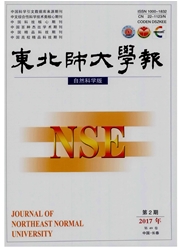

 中文摘要:
中文摘要:
利用盆栽实验,对幼苗期灰绿和黄绿两个生态型羊草用NaCl和Na2CO3进行胁迫后,采用紫外分光光度法对可溶性蛋白含量进行了测定.定量分析结果表明,在不同浓度NaCl和Na2CO3胁迫条件下,灰绿型和黄绿型羊草可溶性蛋白质含量分别是对照的2.52~3.52倍,4.87-10.32倍,1.60~3.58倍和1.95~6.67倍.灰绿型和黄绿型羊草可溶性蛋白质含量在NaCl浓度为100mmol/L和25mmol/L,Na2C03浓度为100mmol/L和50mmol/L时达到最高值.由此表明,灰绿型和黄绿型羊草具有一定的耐盐碱能力,且灰绿型羊草的耐盐碱能力高于黄绿型羊.
 英文摘要:
英文摘要:
At the stage of seedlings,the which are planted with sand culture an have been determined with ultraviolet tents of soluble protein of tillers of th times,4.87~10.32 times, 1.60~3.58 Na2CO3 salt-alkali stresses gradients th of tillers of grey green and yellow green ecotype L. chinensis, d stressed by NaCl and Na2CO3 salt-alkali stresses gradients, spectrophotometric method. Based on data analysis, the contents of soluble protein of tillers of the grey-green and the yellow-green ecotype were 2. 52 ~ 3. 52 times and 1.94~6.67 times bigger under different NaC1 and an those under no NaC1 and Na2CO3 salt alkali stress,respectively. The contents of soluble protein of tillers of the grey green and the yellow-green ecotype reached the biggest value under NaCI concentration of 100 mmol/L and 25 mmol/L, Na2CO3, concentration of 100 mmol/L and 50 mmol/L, respectively. L. chinensis adapts to severe conditions by means of strain tolerance. In results, there is some salt-alkali tolerance of two experimental populations,but salt-alkali tolerance of grey-green ecotype is stronger than that of yellow-green ecotype. It shows the most important meaning in breeding variety of resisting salt-alkali, harnessing salivation steppe and production.
 同期刊论文项目
同期刊论文项目
 同项目期刊论文
同项目期刊论文
 Germination, growth, osmotic adjustment and ionic balance of wheat in response to saline and alkalin
Germination, growth, osmotic adjustment and ionic balance of wheat in response to saline and alkalin β-diversity patterns of plant community in fragmented habitat in a degenerated meadow in Songnen Pla
β-diversity patterns of plant community in fragmented habitat in a degenerated meadow in Songnen Pla Phenotypic plasticity of life history characteristics: quantitative analysis of delayed reproduction
Phenotypic plasticity of life history characteristics: quantitative analysis of delayed reproduction 期刊信息
期刊信息
